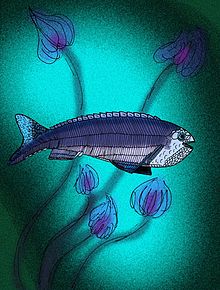| Anaspidomorphs Temporal range: Early Silurian - Late Devonian | |
|---|---|
 | |
| Reconstruction of the Late Silurian anaspid agnathan Cowielepis ritchiei, of Cowie Bay, Scotland | |
| Scientific classification | |
| Domain: | Eukaryota |
| Kingdom: | Animalia |
| Phylum: | Chordata |
| Subphylum: | Vertebrata |
| Superclass: | † Anaspidomorphi |
| Subtaxa | |
Anaspidomorphi (anaspidomorphs) is an extinct superclass of jawless fish.
According to the newer taxonomy based on the work of Nelson, Grande and Wilson 2016 [1] and van der Laan 2018, [2] the phylogeny of Anaspidomorphi looks like this:
- Superclass †Anaspidomorphi
- Order † Euphanerida
- Family †Euphaneropidae Woodward, 1900
- Order † Jamoytiiformes Halstead-Tarlo, 1967
- Family †Achanarellidae Newman, 2002
- Family †Jamoytiidae White, 1946
- Class † Anaspida Janvier, 1996 non Williston, 1917
- Order † Endeiolepidiformes Berg, 1940
- Family †Endeiolepididae Stensio, 1939
- Order † Birkeniiformes Stensiö, 1964
- Family †Pharyngolepididae Kiær, 1924
- Family †Pterygolepididae Obručhev, 1964
- Family †Rhyncholepididae Kiær, 1924
- Family †Tahulalepididae Blom, Märss & Miller, 2002
- Family †Lasaniidae Goodrich, 1909
- Family †Ramsaasalepididae Blom, Märss & Miller, 2003
- Family †Birkeniidae Traquair, 1899
- Family †Septentrioniidae Blom, Märss & Miller, 2002
- Order † Endeiolepidiformes Berg, 1940
- Order † Euphanerida